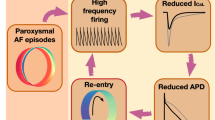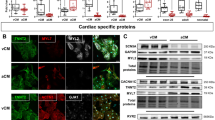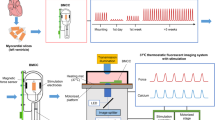Abstract
Animal studies have documented the presence of marked, species-dependent, developmental changes in the properties of the L-type calcium current in cardiac myocytes. In an effort to understand the postnatal changes which occur in the calcium current in human heart, we characterized the calcium current in atrial myocytes isolated from 17 pediatric and older children (ages 3 d to 14 y) and 12 adult (ages 43-79 y) human hearts using the whole-cell patch clamp technique. In contrast to animal models, we found no evidence for age-related changes in calcium current density, steady-state inactivation, or kinetics of recovery from inactivation, suggesting that, in human atrium, calcium channels are in many aspects functionally mature at the time of birth. However, statistically significant differences were found in the kinetics of calcium current inactivation, with calcium current measured in cells isolated from pediatric human atria inactivating approximately 2-fold faster than cells isolated from adult hearts. These results suggest a possible role for age-related changes in calcium current inactivation in the shortened action potential duration observed in pediatric compared with adult human atrium.
Similar content being viewed by others
Log in or create a free account to read this content
Gain free access to this article, as well as selected content from this journal and more on nature.com
or
Abbreviations
- ICa:
-
calcium current
- HEPES:
-
N- 2-hydroxyethylpiperazine-N′-2-ethanesulfonic acid
References
Cohen NM, Lederer WJ 1988 Changes in the calcium current of rat ventricular myocytes during development. J Physiol 406: 115–146
Tohse N, Meszaros J, Sperelakis N 1992 Developmental changes in long-opening behavior of L-type Ca channels in embryonic chick heart cells. Circ Res 71: 376–384
Wetzel GT, Chen F, Klitzner TS 1993 Ca channel kinetics in acutely isolated fetal, neonatal, and adult rabbit cardiac myocytes. Circ Res 72: 1065–1074
Cohen NM, Lederer WJ 1993 Calcium current in single human cardiac myocytes. J Cardiovasc Electrophysiol 4: 422–437
Crumb WJ, Pigott JD Jr, Clarkson CW 1995 Comparison of Ito in young and adult human atrial myocytes: evidence for developmental changes. Am J Physiol 268:H1335–H1342
Hamill OP, Marty A, Neher E, Sakmann B, Sigworth FJ 1981 Improved patch-clamp techniques for high-resolution current recording from cells and cell-free membrane patches. Pflugers Arch 391: 85–100
Akaike H 1974 A new look at the statistical model identification. IEEE Trans Automatic Control AC- 19: 716–723
Horn R 1987 Statitical methods for model discrimination. 51: 255–263
Anversa P, Olivetti G, Loud AV 1980 Morphometric study of early postnatal developmental in the left and right ventricular mycoardium of the rat. Circ Res 46: 495–502
Le Grand B, Hatem S, Deroubaix E, Couetil JP, Coraboeuf E 1991 Calcium current depression in isolated human atrial myocytes after cessation of chronic treatment with calcium antagonists. Circ Res 69: 292–300
Ouadid H, Seguin J, Richard S, Chaptal PA, Nargeot J 1991 Properties and modulation of Ca channels in adult human atrial cells. J Mol Cell Cardiol 23: 41–54
Josephson IR, Snachez-Chapula J, Brown AM 1994 A comparison of calcium currents in rat and guinea pig single ventricular cells. Circ Res 54: 144–156
Kass RS, Sanguinetti MC 1984 Inactivation of calcium channel current in the calf cardiac Purkinje fiber. Evidence for voltage- and calcium-mediated mechanisms. J Gen Physiol 84: 705–726
Wetzel GT, Chen F, Klitzner TS 1991 L- and T-type calcium channels in acutely isolated neonatal and adult cardiac myocytes. Pediatr Res 30: 89–94
Janse MJ, Anderson RH, van Capell FJL, Durrer D 1976 A combined electrophysiological and anatomical study of the human fetal heart. Am Heart J 91: 555–562
Hadley RW, Hume JR 1987 An intrinsic potential-dependent inactivation mechanism associated with calcium channels in guinea pig myocytes. J Physiol 389: 205–222
Rose WC, Balke CW, Wier WG, Marban E 1992 Macroscopic and unitary properties of physiological ion flux through L-type Ca channels in guinea-pig heart cells. J Physiol 456: 267–284
Cavalie A, Pelzer D, Trautwein W 1986 Fast and slow gating behaviour of single calcium channels in cardiac cells. Relation to activation and inactivation of calcium channel current. Pflugers Arch 406: 241–258
Campbell DL, Giles WR, Hume JR, Shibata EF 1988 Inactivation of calcium current in bullfrog atrial myocytes. J Physiol 403: 287–315
Hume JR, Uehara A 1985 Ionic basis of the different action potential configurations of single guinea-pig atrial and ventricular myocytes. J Physiol 368: 525–544
Escande D, Loisance D, Planche C, Coraboeuf E 1985 Age-related changes of action potential plateau shape in isolated human atrial fibers. Am J Physiol 249:H843–H850
Acknowledgements
The authors thank Mary Richardson, R.N., for technical assistance, and Dr. Arthur S. Pickoff for helpful discussion.
Author information
Authors and Affiliations
Additional information
Supported by National Heart, Lung, and Blood Institute Grants HL-36096 and K04 HL-02520.
Rights and permissions
About this article
Cite this article
Roca, T., Pigott, J., Clarkson, C. et al. L-Type Calcium Current in Pediatric and Adult Human Atrial Myocytes: Evidence for Developmental Changes in Channel Inactivation. Pediatr Res 40, 462–468 (1996). https://doi.org/10.1203/00006450-199609000-00016
Received:
Accepted:
Issue date:
DOI: https://doi.org/10.1203/00006450-199609000-00016



